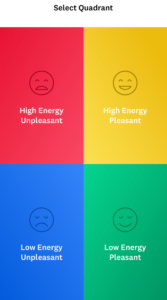
With emotions running high for just about everyone, now is the necessary opportunity to really talk about how we all feel and help children and teens do the same, and realize why social emotional learning matters to our lives.
Stressed, anxious, pressured, depressed. These words describe how many of us feel right now. But do we know which one is more accurate for us? If someone asked you “How are you feeling?” would you actually use one of those words? Or would you use the very common “fine” or “okay” or “busy”—none of which are really how you feel. I’m a big fan of “bleh” these days, but what does it even mean? It’s more important to know the answer than you might think.
Knowing how we feel matters. Our emotions affect what we pay attention to and how we learn, the decisions we make, our social relationships, and our health. If we can successfully manage our emotions, we are set up for positive outcomes—whether it be learning content, maintaining positive family relationships, making good decisions, or staying healthy. These are all important facets of our lives, especially during a time of crisis.
Health is at the front of our minds. We don’t want negative emotions that lead to lack of sleep, etc. to weaken our immune systems. We need each other more than ever even if we must be apart. With tensions high, it can be easy to push away the people we need most. The decisions we make now could affect the lives of others. And if we want our students to learn, they need the right mindset to even pay attention. All of those come down to managing emotions.
A Necessary Opportunity for Social Emotional Learning
It’s also the reason there’s been a lot of talk about social emotional learning in schools for the last couple of decades, but, from what I’ve seen, it’s been limited to counselor assemblies or advisory lessons that neither student nor teacher take very seriously. And if you’re curious about the jargon of SEL, here’s the official description of what a social emotional school looks like according to the Collaborative for Academic, Social, and Emotional Learning (CASEL):
Children and adults understand and manage emotions, set and achieve positive goals, feel and show empathy for others, establish and maintain positive relationships, and make responsible decisions.
Now may just be the best necessary opportunity to dig into social emotional learning with our families. I use the term necessary opportunity because it’s something that if we haven’t put our minds to before, is absolutely needed. In this pause, where we literally can’t run around and are stuck at home, we have the opportunity. There is plenty to talk about and we need the words to label it.
Just think about your current situation for a second. Do you have the pressure of working from home and helping educate your children? Do you feel anxiety because you no longer have a job or your hours have been cut? Can you even wrap your mind around helping your son with Algebra right now? Are you stressed thinking about when is the right time for your family to venture out? And what about your kids’ emotions? Disappointment from missing events, sadness from missing their friends, anger because they can’t understand why they can’t visit grandma. Emotions everywhere!
I’ve been there. I taught freshmen in high school—every day was a new maelstrom of emotions brewing. And I got to be their overwhelmed guide through a lot of them. But I needed be their guide if I wanted them to learn in my classroom. As I said, emotions matter to learning. If my students didn’t feel safe and welcome and understood, they weren’t going to care about writing a thesis statement. The same goes for your kids learning in your living room.
It’s not just teens and younger children. I know my emotions have been on a pandemic roller coaster. I’m an adult with a master’s degree who’s taken plenty of educational psychology classes and studied social emotional learning. I’m pretty good at managing my emotions—but it’s hard because so many emotions are amplified or coming at me all at once.
Understanding and Regulating Your Emotions
One of my coping skills is exercise. It’s why I love training for marathons and half marathons. There is something cleansing about a 16-mile training run (just trust me here). But right now, recovering from a foot injury, I can’t set out for quite that long of a dash, so I run 3–4 times a week and walk several miles the other days. During those walks, I’ve taken to listening to podcasts. One of my favorite ones is Unlocking Us with Brené Brown. I’ve read Brown’s books, watched her Netflix special, etc. I really enjoy some of the topics she chats with experts about on her podcast.
Recently, she invited Marc Brackett, author of the book Permission to Feel, to her show. As I listened, I thought a few things: First, I was doing the right thing in how I handled student emotions in the classroom, but second, I wish I had this resource to help me better help students regulate different emotions, and third, how can I use this to not only help myself, but also help the teachers I coach deal with their own and their students emotions. I finished my walk and bought the ebook.

Bracket, along with his colleagues at the Yale Center for Emotional Intelligence, have developed an approach to help us all better understand and regulate our emotions. They call it RULER:
- Recognize
- Understand
- Label
- Express
- Regulate
The first step, Recognize, is about knowing generally where you are on a chart they call the Mood Meter. It measures emotions based on how they rate in energy and pleasantness. Yellow is high pleasant, high energy (think enthusiastic or hopeful). Green is high pleasant, low energy (think chill or peaceful). Blue is low pleasant, low energy (think discouraged or disappointed). Red is high energy, low pleasant (think irritated or worried). If you had to put yourself in a quadrant, where would you be?
The second step, Understand, is about figuring out why you are there. Did you just get some good news? Some bad news? Did your child just push THAT button? What is going on that is affecting how you feel right now?
The third step is to Label it. This is where I challenge you to up your emotional vocabulary game. Is your happiness joy or contentment? (They are in different quadrants, by the way.) Are you jealous or envious? (One is about fearing losing something you have, the other is about wanting something someone else has.) It’s important to label your feelings, so you can better regulate them.
The fourth step, Express, is all about how you do or do not express your emotions. This is about giving yourself and the people around you permission to feel all the emotions. As Bracket writes, “Accept and acknowledge that there’s no shame in expressing our emotions.”
The fifth step is all about Regulating your emotions. How can you deal with your stress and anxiety? How can you help your children deal with all their emotions? This was the section I really wish I had when I was a teacher. This is where you learn different strategies to help. We can practice mindful breathing, we can look ahead and avoid triggers, we can distract ourselves, we can reframe, or we can have what they call a Meta-Moment, where we try to act as our best selves and avoid overreacting.
In my next blog, I’ll share some practical examples of what social emotional learning might look like in your home this summer. We’ll explore some concrete (and simple) steps you can take to up your emotional game at home. We have this necessary opportunity. Let’s use it!
About the Author
Kristen Henry is an independent education consultant at KH Literacy Education. Based on her experience as a literacy educational leader, she guides teachers to use research-based practices, be more confident in the classroom, and change students’ lives. Her book, Guiding Questions, helps instructional coaches, administrators, and teachers learn to have more productive conversations about improving their teaching practice.
Read, Listen, and Play About Social Emotional Learning
- Unlocking Us with Brené Brown
- Permission to Feel, Marc Brackett (2019)
- Mood Meter app
- “Embracing Emotional Learning During a Pandemic,” Kristen Henry, San Antonio Charter Moms, June 17, 2020
- “Big Goals, Relevant Work, and Flexibility: How to Make At-Home Learning Work for You,” Kristen Henry, San Antonio Charter Moms, April 15, 2020
- “Self Care While Staying at Home,” Lora Idol, San Antonio Charter Moms, April 6, 2020
- “Keep Calm and Parent On: Advice for Accidental Homeschoolers,” Caitlyn Baker and Shannon Ruddell, San Antonio Charter Moms, April 3, 2020
- “Resources for Staying Active With Kids While Social Distancing,” Amy Johnson, San Antonio Charter Moms, March 19, 2020
- “Learning Social And Emotional Skills Can Improve Student Academic, Behavioral Outcomes,” Texas Public Radio, January 12, 2020
- “CASEL President on the Importance of Maintaining Quality in Social-Emotional Learning, Paying Attention to the Adults and Work as the Next SEL Frontier,” Bekah McNeel, 74 Million, December 9, 2019
